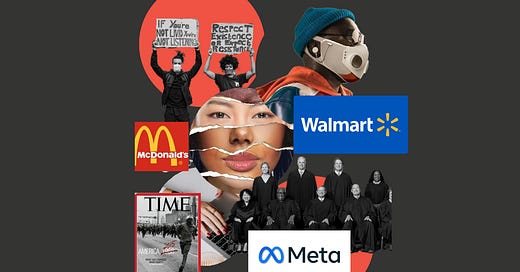Dear Leader: It Happened. Now What?
Welcome to the Change Newsletter by Reframe! It is our first publication and I hope you like the format and approach. Either way, share your feedback. The newsletter is for leaders who want to better understand how to build inclusive experiences at scale.
The address opens with “Dear Leader” is intentional because we want to remind the reader what responsibility comes with being a leader. Want to learn more? Subscribe and join our community: http://eepurl.com/i7lhos.
Dear Leader:
By now you’ve seen team ANTI and PRO [fill in the blank] forming on Main Street and Wall Street. As a leader you are in the middle of the rising walls of tension and temperature that will not only test your mental wellbeing and the stability of your company, but also test our democracy.
You’ve seen the headlines from corporate America announcing their ANTI and PRO positions from the likes of Meta, McDonalds, Lowe’s, Wal-Mart, Costco, Apple and a host of other Fortune 500 organizations will litter our path to the United States Supreme Court.
Historical markers rooted in racial, ethnic, political and social motivations present a cross-road where many will question the role humanity plays or does not in your leadership decisions and outcomes.
Why is this moment different?
Since The 1960s, Racially, Ethnically, Attitudinally and Behaviorally, The People Have Changed.
The last time America and corporate America were at a similar crossroad in the 1960s, the problem to be solved was how would society go from segregated too integrated. The landmark piece of legislation that solved the problem was the 1964 Civil Rights Act outlawing discrimination based on race, color, religion, sex, or national origin was enacted.
The innovation that followed addressed how America and corporate America integrated women and people of color in the workplace and marketplace. For corporations pioneering enough to source volume and market share from people of color, birthed the practice of multicultural marketing. For corporations looking to increase their share of women and people of color in the workforce, leaders innovated and began the practice of diversity, then equity and now inclusion (DEI). For corporations looking to impact communities economically and equitably, supplier diversity initiatives were introduced. America and corporate America innovated to solve the business problem.
Here we find ourselves again…
America and corporate America is at another cross-road. This time the problem to be solved is whether or not America and corporate America should change.
In the coming days, months and years, there is not a leader who is immune to being caught in the cross hairs of the ANTI and PRO movements. You will inevitably be asked to make decisions about what team to join. Below are three things to think about before choosing a side.
What Problem Am I Solving For?
Ask yourself if you are solving an old or new problem. Does this problem require innovation? If not, then you are likely solving for an outcome that reflects an old problem. For example if you are being asked if you should expand your audience for a more inclusive go-to-market activation, it requires new investment decisions and innovative thinking. Embedding the new audience opportunity into the financial plan at the beginning of the planning cycle ensures changing the level of investment for a more sustainable outcome versus an opportunistic “one-off”. If it’s a “one - off” opportunity or "add on" then you are likely being asked to grow with your base customers and the outcome will not future proof your business for the long term.
Am I Using The Right Approach To Solve The Problem?
As a leader you are going to be asked to make decisions and tradeoffs that either set the organization backwards or forward. This requires choosing the right approach for solving a problem. Using the above example, as a leader you may be asked to expand your audience to be more inclusive of diverse audience segments or stick with your base customers. Demographically America is approaching +50% of the US population that is racially and ethnically diverse. This means as a leader you have to ask yourself, are you solving the old or a new marketplace. Risk mitigation is a real thing and sometimes choosing the old marketplace approach versus a new approach does not mean it is the wrong decision.
Should I Innovate?
You will be met with the question of should I pursue incremental gains or exponential gains for the short - mid - long term business cycle. If the macro environment is volatile and nuanced, you will be asked to pull back or take a more conservative approach. What this means usually is a lack of investment to innovate. The decision to innovate or not signals you are not future proofing your organization. The generation of leaders in the 1960s innovated and solved the dynamic business problem of going from a segregated to integrated marketplace and workplace.
Since the 1960s, the people have changed and this era requires innovative leaders. Joining Team ANTI or PRO is an act of PUNTING a decision to not innovate and solve the problem of our generation.
About The Author
Jeffrey L. Bowman is the founder and CEO of Reframe Inc. Reframe helps leaders accelerate inclusive change and growth using Reframe Consulting Services and Reframe AI Technologies. Entrepreneur, published author, inventor and pioneer, he and his co-founder, developed automated technology that scales inclusive experiences using artificial intelligence and machine learning.



